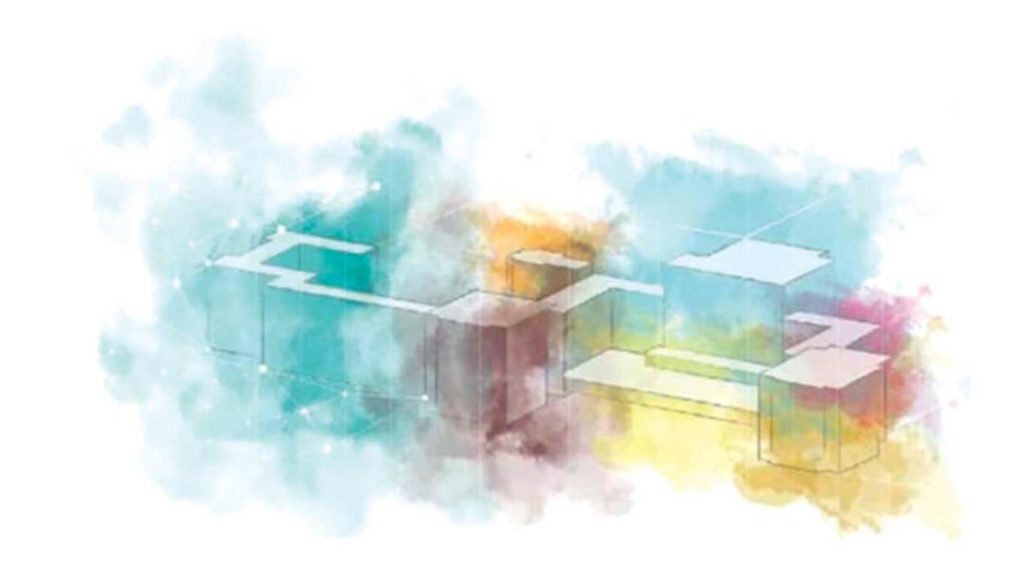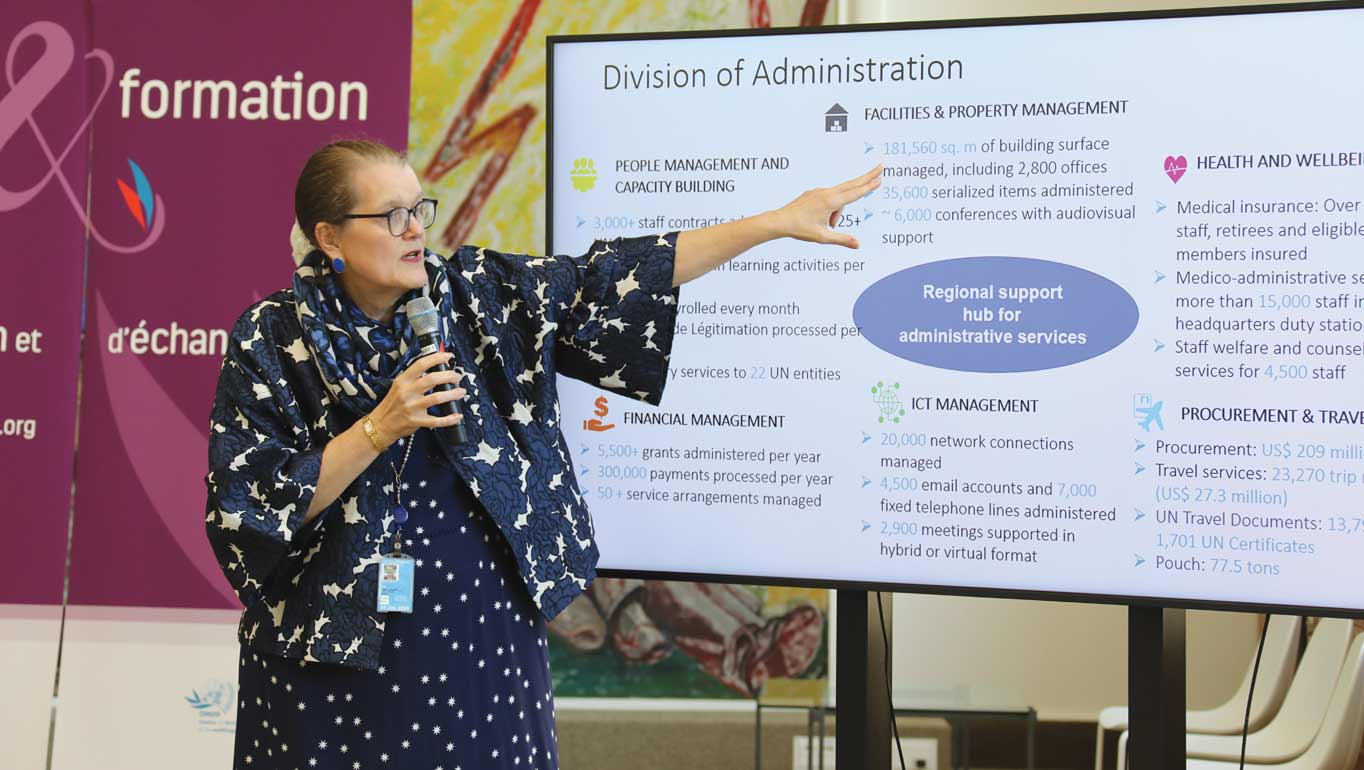In an exclusive interview, we delve into the intricacies of Kira Kruglikova’s new role and the weighty responsibilities that come with it.
Kira, congratulations on your new role. Can you tell us more about your role and your priorities as the newly appointed Director of Administration at UNOG?
Thank you, I am honored the Director-General gave me this opportunity and I am excited to contribute to the organization in this new capacity. Leading UNOG’s Division of Administration (DOA) is also a great challenge. DOA is first and foremost a service provider, supporting the UN’s work towards peace, rights and wellbeing. DOA provides services in human resources, budget and finance, central support and ICT to entities and staff located here and elsewhere. DOA is effectively the landlord of the Palais des Nations, managing the buildings, the grounds, the IT network, and the physical conference rooms and their infrastructure. The United Nations Office at Geneva hosts over 5500 high-level meetings annually and one of the Director-General’s priorities is keeping the Palais a modern hub for conferencing.
My highest priority is to provide outstanding core administrative services. The Division excels in many areas and I’m fortunate to lead such a solid team. We are still working on our vision statement, but the core of it is to sustainably meet the needs of those we serve at a fair price. People receiving our services should have what they need when they need it with a minimum effort on their part; people paying for our services should see they get good value for money and people providing services should have the resources they need to do so, day in and day out, with the satisfaction of a job well done. So much has already been achieved – one award-winning example of DOA’s innovation in service provision is our successful Client Support Centre (CSC). Whenever I’ve used the CSC as a staff member, I’ve had great results.
We are on a mission to expand that excellence through improving our communication with clients, addressing overlapping functions, and simplifying our service delivery, ensuring all stakeholders are consistently well-informed and well-served. I think it’s important we remember our place in the global landscape: we are here to strengthen and support those who have substantive roles in the organization, who are working to promote international cooperation and peace. What we do is make sure they can perform their duties under the best possible conditions, with minimal friction.
You’ve inherited the massive Strategic Heritage Plan (SHP), a renovation project costing over CHF 800 million. How are you addressing potential setbacks, especially in such a grand project?
The SHP is a huge project that the Member States adopted in 2015 to keep the Palais des Nations one of the premier conference centers in Europe and provide a safe, effective workplan for its occupants. A lot has happened in the eight years since then, including construction of the Building H, where my office is. Renovation of the historic Palais is well underway with some buildings already back from renovation – Section AC and Building D, and others to be done soon– the remaining parts of Building A (Assembly Hall and Section AB) and Building S1. The contract for the Building E work – removing the tower and renovating the conferencing area, was signed in January. David Mc Cuaig, the Project Director, has built an excellent team and they’ve done great work under difficult circumstances. Their latest initiative, bringing Lean construction management to the worksite, is typical of their proactive approach to addressing problems. Lean is already showing benefits through improved collaboration and clearer understanding of what is needed to keep on track.

Jumping into the project at this late stage means that my role is more about looking at what happens when the project is done, currently scheduled for the second half of 2026. DOA colleagues in the Facilities Management Section and the ICT Service will be operating and maintaining the renovated Palais, so I have prioritized their active engagement in the project. It’s also about asking a lot of questions for me to understand where things are going and whether they still make sense – and almost always they do. When they don’t, I have a role in approving Design Program Changes (DPCs), which are how the SHP adjusts to reflect new requirements and changed technologies. Such changes can generate costs and/or delays, so are not undertaken lightly. I am committed to consulting widely and taking decisions quickly, balancing the benefits of the change against its impact on an already tight budget and a delayed schedule.
As UNOG’s Focal Point for Disability Inclusion, I also very much appreciate the work SHP is doing to improve the accessibility of the Palais for people living with disabilities. Whether it’s adjusting the tables in conference rooms so wheelchair users can fit or installing guiding strips for people who are blind or with low visibility, the new Building H and newly renovated buildings better fit the UN’s Disability Inclusion Strategy (UNDIS). I’m so excited about these upgrades and we are planning a special event for World Toilet Day in November to showcase the new accessible toilets.
Let me close by saying how much I love my work with the SHP. My experience in conferencing and as one of the major tenants of the Palais has shaped my approach to the project. I’m very grateful to have so many dedicated professionals from different areas working together. SHP is a complicated, intricate puzzle and I always enjoy working across functions, finding the best way forward together. What we do together here and now will greatly shape the experience of staff, delegates, and visitors for decades to come.
We’d love to know more about your day-to-day. What does a typical day look like for you?
My days are typically packed with meetings from 9 a.m. when I start through to late afternoon, and I try to leave by 7 p.m. Time zone differences also occasionally mean late-night sessions with our colleagues in New York. This is how I like to work: engaging in collaborative sessions across teams, with clients, and through internal discussions. Participating in conversations and confronting diverse perspectives is what keeps my thinking sharp. I take advantage of my lunch break to spend time with colleagues and catch up with friends. But it’s not all work!
Outside the professional sphere, balance is also something I strive for. My mornings often begin with a walk – a moment to step outside and appreciate our beautiful surroundings, followed by 15 minutes of meditation. Dancing is another passion of mine and I try to attend classes right here at UNOG a couple of times a week. I also make it a point to connect weekly with my family back in the U.S. through online bridge playing sessions. To literally stay flexible – important at my age – I do pilates every week. At night, once I’ve finished with emails, I do some online language classes and a quick glance at the news. I’ve started writing short stories every day, modeled after the morning pages practice in Julia Cameron’s ‘The Artist’s Way’. By the time I go to bed, the house is usually already quiet, and I am often the first one up to start the day… It’s safe to say I don’t have a lot of down time!



